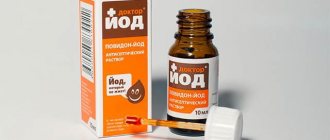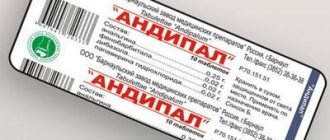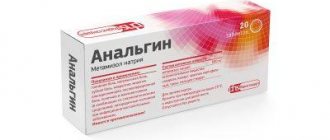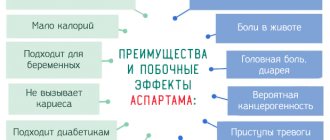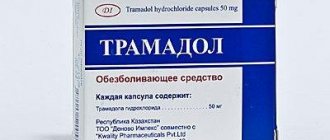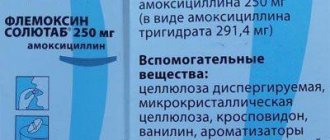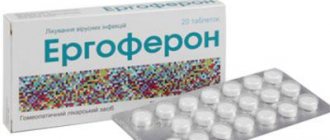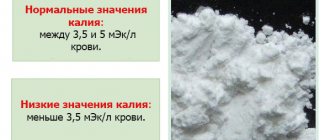Calcium gluconate is a drug that is used to replenish calcium deficiency in the body . It can only be used as prescribed by a doctor. If taken incorrectly or if there are contraindications to its use, it can cause great harm to the body. This article discusses an overdose of calcium gluconate, its causes, symptoms, as well as first aid methods and treatment components for its development.
How to understand excess
Calcium (Ca) is an element necessary for the normal functioning of the body. Almost ninety percent of it is found in the bones, the rest is present in the blood plasma.
It should be noted that excess of the element cannot occur in a person with normal health. Most often, this is due to certain factors.
Factors:
- problems with hormonal levels,
- heredity,
- oncological diseases,
- overdose of vitamin D.
Accumulation of the element occurs as a result of dysregulation of its distribution and absorption. The process of calcium absorption is activated with the help of hormones and vitamin D3.
If a vitamin is constantly present in the body in excess, then the element accumulates. The presence of excess calcium may remain for some time after stopping vitamin D supplementation.
As a result, hypercalcemia develops. Most often, women and older people suffer from this disease. Excessive levels of the substance are detected during a blood test.
In addition to the vitamin, various hormones also participate in the distribution of calcium in the body. You can read about overdose of other vitamins on our page here
Hormones:
- Parathyroid hormone. Produced by the parathyroid glands. Regulates the exchange of calcium between blood and bone tissue (that is, it stimulates the release of the element from the latter and promotes absorption into the plasma).
- Calciotonin. Synthesized by the thyroid gland, the action is opposite to parathyroid hormone. With normal levels of both hormones, the amount of calcium also remains normal, and there is no overdose or deficiency.
- In addition, hormones such as insulin, androgens, estrogens, and somatropin are also involved in the process. If there is a violation of the quantity of at least one of them, then a violation of the entire process of perception of the element by the body occurs.
Often the cause of increased levels is improper use of medications.
Medicines:
- Calcium gluconate. This medication is prescribed by doctors to treat hypocalcemia. There are two forms of the drug - solution and tablets. Its use must be strictly according to the doctor's instructions, otherwise an overdose occurs.
- Advertisements for the drug “Calcium D3 Nycomed” constantly talk about its benefits. But, unfortunately, it does not say that it should be used as prescribed by a doctor. As a result of its ready availability in pharmacies, people self-prescribe this medicine. The result may be an overdose.
- Calcium chloride is prescribed by doctors to compensate for the deficiency of this element in the body. The drug is administered intravenously in a dosage calculated depending on the condition of the body. An overdose of calcium chloride in this case may occur due to the fault of medical personnel due to inattention. In addition, some people try to carry out such procedures at home without thinking about the consequences.
Constant consumption of dairy products can also cause an increase in the level of the substance in the blood.
*Oxalates
No more than 0.01%.
Determination is carried out by ion-exchange HPLC.
Mobile phase (MP). 0.212 g of anhydrous sodium carbonate and 63 mg of sodium bicarbonate are placed in a 1000 ml volumetric flask, dissolved in water for chromatography, the volume of the solution is adjusted to the mark with the same solvent and mixed.
Regenerating solution. 1.23 g of concentrated sulfuric acid is added to 200 ml of water for chromatography, the volume of the solution is adjusted to 1000 ml with the same solvent and mixed.
Test solution. About 1.0 g (exactly weighed) of the substance is placed in a 100 ml volumetric flask, dissolved in water for chromatography, the volume of the solution is adjusted to the mark with the same solvent and mixed.
Sodium oxalate solution. 0.0152 g of sodium oxalate is placed in a 100 ml volumetric flask, dissolved in water for chromatography, the volume of the solution is adjusted to the mark with the same solvent and mixed.
Reference solution. About 1.0 g (exactly weighed) of the substance is placed in a 100 ml volumetric flask, dissolved in water for chromatography, 0.5 ml of sodium oxalate solution is added, the volume of the solution is adjusted to the mark with the same solvent and mixed.
Chromatographic conditions
| Pre-column | 30 × 4 mm with suitable strong anion exchange resin, 30 - 50 µm; |
| Columns 1 and 2 | 25 × 0.4 cm with suitable strong anion exchange resin, 30 - 50 µm; |
| Anion suppression column | connected in series with the pre-column and analytical columns and equipped with a micromembrane that separates the mobile phase from the regenerating solution flowing in the opposite direction; |
| PF flow rate | 2 ml/min; |
| Regenerating solution flow rate | 4 ml/min; |
| Detector | conductometric; |
| Sample volume | 50 µl. |
The chromatographic system is considered suitable if the relative standard deviation of the oxalate peak area is not more than 2.0% over 5 consecutive injections; asymmetry factor no more than 1.2.
The test solution and the reference solution are chromatographed. The oxalate content in the substance in percent (X) is calculated using the formula:
Where
S is the area of the oxalate peak in the chromatogram of the test solution;
S is the area of the oxalate peak in the chromatogram of the reference solution.
Symptoms and signs of intoxication
Calcium poisoning - its first symptoms appear gradually. The very first sign of a violation of the level of the element in the blood is frequent constipation. They provoke the development of flatulence and pain in the abdomen.
An overdose of a microelement also contributes to the formation of kidney stones. Excess substance tends to be deposited on the walls of blood vessels.
For men, a constant overdose is fraught with the occurrence of malignant neoplasms of the prostate gland.
What signs can be used to determine a possible calcium overdose?
Symptoms:
- dry oral mucous membranes,
- nausea, vomiting,
- the person doesn't want to eat
- fatigue, depression,
- dizziness,
- indigestion,
- problems with coordination, consciousness,
- dehydration,
- convulsions,
- weight loss,
- problems in heart function,
- kidney failure.
If such signs of overdose are detected, you must immediately stop taking the drugs and provide assistance to the victim.
Drug interactions
Calcium gluconate does not react chemically with components of other medications. However, it is able to slow down the effect of etidronate, stramustine, and other bisphosphonates.
Calcium gluconate weakens the pharmacological effect of taking tetracycline antibiotics and anti-inflammatory drugs of the quinolone category. When taking medications saturated with fluoride and iron simultaneously, a time interval of more than 3 hours should be maintained between their use.
Calcium gluconate has the property of reducing the bioavailability of antiepileptic and anticonvulsant drugs of the phenytoin series.
The tablets increase the rate of cardiac toxicity of pharmacological pacemakers based on glycosides. When taking calcium gluconate and calcitonin medications in parallel, the clinical effect of the latter is slightly reduced.
In combination with quinidine, the injectable drug slows intraventricular conduction, which causes impaired myocardial contractions. It is not advisable to combine calcium gluconate with diuretics of the thiazide category.
This significantly increases the likelihood of oversaturation of the body with Ca2+. The simultaneous use of calcium gluconate with carbonate, sulfate, and salicylic drugs is not prescribed.
How to remove excess calcium from the body
If a person has an overdose of this element, then a natural question arises about how to correct it.
This treatment should be carried out by a doctor. However, at home you can also take certain measures to reduce the level of the trace element. This substance enters the body mainly through food, so you should adjust your diet and exclude some dishes from it.
Dishes:
- dairy products,
- sesame oil,
- nuts,
- halva,
- dark chocolate,
- wheat bread.
A good way to help bring the amount of the element to normal and avoid an overdose of calcium is distilled water. The fact is that it, without containing trace elements, dissolves those present in the body.
Then the excess is withdrawn. Therapy with such a drink is possible for a couple of months, after which it is replaced with boiled or filtered one.
Photos of dishes with calcium:
Other Applications
Sodium gluconate, which is obtained in laboratory conditions, is used not only as a flavoring additive. This substance is often used for:
- Washing membranes in dairy plants. In this case, the macromolecules of milk and whey are separated. Membranes require constant cleaning for high permeability, microbiological purity and selectivity.
- For washing bottles. Sodium gluconate is included in detergents, since the substance is resistant to hydrolysis, biodegradable and has high efficiency in an alkaline environment.
- Removing scale during beer production. The use of detergent compositions with sodium gluconate does not allow calcium to settle on the walls of containers.
- Washing hard surfaces in industrial plants to remove traces of mineral and organic deposits. It is sodium gluconate that allows you to eliminate such contaminants.
- Cleaning molds necessary for making glass products. Such containers should always be washed after use. Sodium gluconate is part of alkaline solutions. In this case, the compound is able to remove rust, silicate and carbon deposits.
- The substance is also used in the metallurgical, oil refining and oil production industries.
First aid and treatment
Overdose treatment is carried out in a hospital. Doctors use various procedures to help remove excess fluid quickly and restore the body.
Actions:
- Stopping medications containing calcium
- Medicines are used to quickly remove the element in the urine,
- It is possible to use a surgical method to remove one of the parathyroid glands so that the element decreases,
- Hormone therapy is used if necessary.
Release forms
The drug is produced in the form of tablets, powder for injection, ready-made solution in ampoules for intramuscular and intravenous administration. The chemical formula of all 3 options is identical.
The finished injection solution additionally contains distilled water. This drug is a colorless liquid in ampoules with a capacity of 5 and 10 ml. The cost varies between 100-150 rubles. per pack in the amount of 10 pcs.
Calcium gluconate tablets
Calcium gluconate - tablets (the price is the lowest among all forms of release) with a flat-cylindrical cross-section, white. They are delivered to pharmacies in cardboard packs, each of which contains 1,2 or 3 cellless contour packages of 10 units. medicine.
1 tablet contains 250 or 500 mg of pharmacologically active component. The approximate price in Russian pharmacies is 30-50 rubles. The powdered drug requires dilution with medical distilled water. This form of release is used mainly in hospitals. The price of powdered calcium gluconate is 60-90 rubles.
Pregnant women and children
Calcium is very important during pregnancy. Its deficiency can lead to complications during childbirth and problems with fetal development.
The expectant mother needs this element to maintain her teeth and bones in normal condition.
Often, if there is a shortage of a substance, doctors prescribe drugs containing it.
Preparations:
- Calcium d3-nycomed,
- Complivit calcium-d3,
- Calcium gluconate in tablets or injections.
Any of these remedies should only be taken under medical supervision. An overdose of calcium during pregnancy can cause disruption of the functioning of many organs.
In children, calcium is necessary for the normal development of bones and teeth, and it supports muscle tone. With its deficiency, growth and posture are impaired, legs are bent, and teeth constantly hurt. In this case, doctors use various vitamin therapy to restore normal levels.
An overdose of a microelement in children usually occurs accidentally when they swallow a large amount of the drug left unattended by an adult. In such cases, gastric lavage is done and a doctor is called. Treatment is carried out in a hospital.
Chemical properties
Sodium Gluconate, what is it? It is a salt formed by gluconic acid and sodium. In order to more accurately understand what it is, consider the formula of Sodium Gluconate. Chemical formula of the substance: NaC6H11O7, racemic formula: HOCH2(CHOH)4COONa. The product is highly soluble in ethyl alcohol and water. It is synthesized in the form of transparent small crystals. Molecular mass of chemical compound = 218.1 grams per mole. The product is obtained by the reaction of alkaline fermentation of cellulose.
Sodium Gluconate is used:
- in the manufacture of industrial alkaline detergent compositions as complexing agents;
- in construction to slow down the hardening of concrete and other building mixtures, improve the plasticity of the compositions;
- in the oil industry for cementing, protecting drilling rigs from corrosion and excessive pressure, and loss of moisture;
- in the production of aluminum and steel in the metallurgical industry;
- as a complexing agent and flavor enhancer in the food industry under code E576.
Approximate menu for diarrhea for 1 day
There are many menu options that present what adults can eat for diarrhea. A healthy solution is six separate meals a day. This means that protein foods are taken separately from carbohydrate foods, in alternation.
- Breakfast. Rice water with the addition of bird cherry compote. Steamed omelette.
- Lunch. Hercules porridge in water (liquid) with the addition of 1 tbsp. spoons of butter. Crackers. Compote (weak) of dogwood, blueberries, cranberries.
- Dinner. St. John's wort infusion (half a glass). Meat or fish broth with pureed herbs (parsley, basil). Boiled lean meat.
- Afternoon snack. Kefir (ryazhenka, acidophilus). Baked fruits (apples, pears, quince).
- Dinner. Black tea. Carrot puree. Semolina.
- For the night. A decoction of bird cherry, knotweed or oak bark.
What foods with calcium cause constipation?
Foods high in micronutrients include:
- cheeses;
- cottage cheese;
- milk;
- bananas.
Dairy products contain quite a lot of calcium. So, for those who consume hard cheeses every day, the stool can become very hard, which makes defecation difficult. Dairy products do not contain fiber, which is why the volume of stool decreases and it becomes denser.
If you consume foods containing calcium in excess, constipation may occur occasionally. This means it is recommended to reconsider your diet.
Probiotics
Obligate intestinal microflora ensures normal digestion and absorption. With diarrhea, it always undergoes changes. To restore it they use
- preparations containing transient microflora (enterol, bactisubtil),
- preparations that contain particles of intestinal microorganisms, their metabolic products (hilak-forte),
- preparations that contain obligate intestinal flora (bifidumbacterin, lactobacterin, acylact, narine, linex)
Diarrhea often goes away on its own even without treatment. Symptomatic therapy for loose stools is effective in most cases, regardless of the underlying cause. But behind harmless symptoms there can be serious problems, from thyrotoxicosis to colon cancer. Therefore, prolonged or repeated diarrhea, blood in the stool or black stools, weight loss - all this is a definite reason to consult a doctor and undergo a full examination.
Contraindications
Hypersensitivity to any component of the drug, hypercalcemia (for example, caused by hyperparathyroidism, vitamin D hypervitaminosis, bone metastases, multiple myeloma), hypercalciuria, renal failure.
Patients using cardiac glycosides or epinephrine should not take calcium salts parenterally. Caution should be exercised in patients with kidney stones, sarcoidosis, and heart disease.
The use of calcium chloride is contraindicated in patients with respiratory failure and acidosis. It should not be used intramuscularly.
The use of gluconolactone is contraindicated in patients with galactosemia. .
Replenishment of fluid losses
And this can be significant – up to several liters – volume. And not only water, but also microelements are lost, so it is better to drink not just water or a decoction of herbs, but pharmacy (Rehydron, citroglucosolan) or self-prepared glucose-salt solutions: per liter of water - a teaspoon of salt, half as much soda, a quarter spoon of chloride potassium, 4 tablespoons of sugar. If there is no potassium salt in the house (which is quite likely), it can be replaced with a glass of orange juice or dried apricot compote.
Features of nutrition for diarrhea during pregnancy
Before loose stools stop during pregnancy, you must give up solid food for one day or day. The loss of vitality should be replenished through the use of decoctions, compotes, jelly, and (lenten) broths. During pregnancy, a woman is not allowed to drink all herbs, but the permitted ones include: mint, black tea, chamomile.
After the diarrhea subsides, you should eat in small portions, following a special diet for a week.
Menu for diarrhea for pregnant women:
- porridge (rice, oatmeal) with water;
- vegetable stew;
- baked fruits, compotes;
- dry white bread crackers;
- broths and soups made with lean fish, chicken or beef;
- boiled lean meat;
- dairy products;
- black tea, bird cherry decoction;
Undesirable foods for diarrhea during pregnancy:
- fat;
- roast;
- smoked;
- flour (only crackers and dryers);
- excessively sour, sweet, salty, hot, spicy;
Recipes for medicinal strengthening dishes for diarrhea:
Rice porridge with chicken
The washed chicken fillet is placed in 3 cups of boiling water. The cooking process lasts up to 40 minutes.
The finished broth is filtered, a glass of rice cereal and a pinch of salt are added to it, and it is cooked for 20 minutes. The meat is chopped and placed in cooked rice, mixed, simmered for 15 minutes, and left for another half hour.
Blueberry (currant or bird cherry) jelly
You need to boil 2 liters of water. Grind 200 g of berries in a bowl. Dilute 4 tbsp. spoons of starch in half a glass of cold water, and add to boiling water, stirring. Add berries. Cook, stirring until cooked (until the jelly becomes transparent).
Take a glass 3 times a day.
Herbal infusion (plantain, sage, calendula)
A mixture of herbs (2 tablespoons) is brewed with a liter of boiling water and left for half an hour. Tea is taken 100 g throughout the day.
Carrot puree
Peel two medium-sized carrot roots, place in a bowl, add a small amount of water with the addition of 1 teaspoon of butter. Simmer until softened. Sauce: sour cream (1 tbsp), tomato paste (1 tbsp). Combine carrots and sauce and puree.
Meat broth with egg
Prepare broth from lean meat. Beat 1 egg, add a little water and beat again. Mix the egg with the broth, bring to a boil, add chopped herbs.
Cottage cheese casserole
Low-fat kefir and grated cottage cheese (200 g each) are combined in a bowl. Add 1 egg and 3 tbsp. spoons of semolina.
Everything is mixed and placed in a baking dish. The casserole is cooked for 40 minutes at an oven temperature of 180 degrees.
Steamed banana and curd pudding
The whites of two eggs are whipped into foam. Beat the yolks, cottage cheese (200 g), butter (100 g), sugar (1 teaspoon) separately. Everything is combined, finely chopped banana is added and mixed thoroughly. The resulting mass is laid out in a mold and sent to a steam bath for half an hour.
Application
Additive E 576 is practically not used in food products.
In rare cases, the substance is used in the manufacture of canned fish and seafood: sodium gluconate prevents metallic oxidation of products.
In the food industry, sodium gluconate is used as a complexing agent to solve purely technical problems:
- removal of calcium deposits during beer production. The containers are treated with a solution of calcium gluconate: the substance binds metal ions, prevents the formation of scale, which impairs the taste and aroma of the drink;
- in the dairy industry, microbiological cleaning of membranes separating the macromolecules of milk and whey. Additive E 576 is used together with another complexing agent - EDTA (E 385) in a 50/50 ratio. The procedure allows you to extend the life of the equipment;
- washing glass bottles for various branches of the food industry. Usually used together with sodium silicates (E 550). The use of the additive as part of alkaline surfactants allows you to remove lime deposits on the necks, prevent the formation of tartar at the bottom of the container, and facilitate the rinsing process.
The good cleansing properties of sodium gluconate have found application in the cosmetics industry. The substance has a mild effect and does not irritate the skin. Included in shampoos, shower gels, and facial washes.
The safety of the additive allows its use in children's cosmetics.
High complexing ability allows the use of E 576 stabilizer in other production processes:
- cleaning, bleaching and degreasing of fibers, stabilizing the color of fabrics in the textile industry;
- pulp bleaching, equipment cleaning in the paper industry;
- as part of household chemicals (washing powders, glass washing liquids): the substance softens water, enhances the effectiveness of surfactants;
- increasing the plasticity and strength of concrete in construction;
- as an additive for cementing drill wells;
- corrosion inhibitor in metallurgy.
Additive E 576 is approved in Russia, Belarus, EU countries, USA, Canada. The safe dose is uncertain.
Main manufacturers
The E 576 additive is supplied to the Russian market by foreign manufacturers:
- HEMA GmbH & Co. KG (Germany);
- BRENNTAG GmbH. (Germany);
- Shanghai Summer Industry Co., Ltd. (China);
- Xiamen Ditai Chemicals Co., Ltd. (China).
The lack of serious research on the possible negative effects of sodium gluconate on health has long cast doubt on the advisability of its use in the food industry. Later it was proven that the substance does not have carcinogenic or mutagenic properties, is not toxic, and is not addictive.
We advise you to pay attention to detergents containing the additive E 576. Sodium gluconate neutralizes the harmful effects of surfactants on the body
Drinking regime. What drinks can you drink?
In case of dehydrating diarrhea, it is necessary to take frequent and abundant drinks rich in essential substances, as well as ordinary clean water. You should drink as often as possible for 6-12 hours until the diarrhea subsides or stops altogether.
The following have a therapeutic effect:
- herbal infusions: St. John's wort, snakeweed, pomegranate peel, oak bark, etc.;
- rice water;
- compotes and jelly: dried apricots, apple, blueberry, bird cherry, rowan, etc.;
- still mineral water);
- black tea);
- Cahors;
- cocoa on water.
Drugs that affect intestinal motility
Lopedium (imodium, loperamide) is the most advertised drug for diarrhea. It is really effective in treating functional disorders associated with increased motility (irritable bowel syndrome). It can also be used for Crohn's disease. However, it is not advisable to use it for infectious diarrhea. Slowing down the evacuation of feces from the intestines will retain toxins and bacterial agents in the body, that is, it will not speed up, but slow down recovery. It is also not effective for diabetic enteropathy and intestinal amyloidosis. Octreotide is an analogue of the hormone somatostatin. It slows down the intestinal motor activity, but at the same time enhances absorption, which makes it indispensable for enteropathies.
Anticholinergics (atropine, platiphylline) and antispasmodics (papaverine, no-spa) reduce intestinal motility; they can be used in the first days for acute diarrhea, especially if it is accompanied by abdominal pain.
Component Properties
Potassium is one of 12 structural elements that make up 99% of the elemental composition of the human body.
Functional properties of potassium:
- participation in the chemical transmission of nerve impulses;
- activation of the work of a number of enzymes;
- stimulation of the heart muscle;
- improvement of kidney function and the condition of the epidermis;
- protecting the body from the negative effects of excess sodium;
- increased urine output during intoxication and swelling to accelerate the removal of toxins from the blood;
- regulation of water balance;
- normalization of blood pressure;
- improving oxygen supply to the brain;
- removal of toxins.


